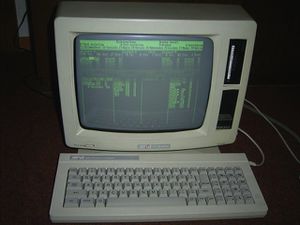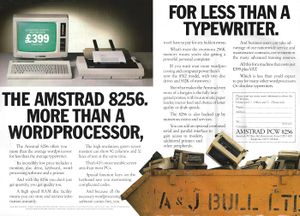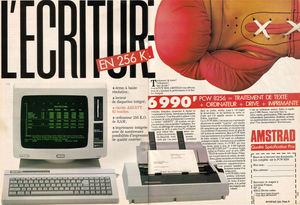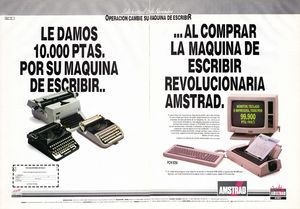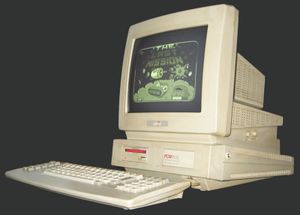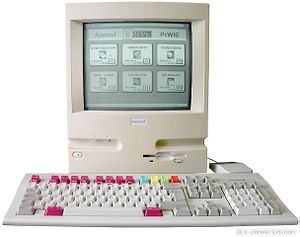(→Links) |
|||
| (54 intermediate revisions by the same user not shown) | |||
| Line 1: | Line 1: | ||
| − | [[Image:pcw8256.jpg|thumb| | + | [[Image:pcw8256.jpg|thumb|Amstrad PCW8256 - The first PCW computer]] |
| + | [[File:Amstrad-pcw8256-ad.jpg|thumb|Amstrad PCW8256 English advertisement]] | ||
| + | [[File:PCW8256 french ad.jpg|thumb|Amstrad PCW8256 French advertisement]] | ||
| + | [[File:Amstrad-pcw8256-spanish-ad.jpg|thumb|Amstrad PCW8256 Spanish advertisement]] | ||
| + | [[Image:Amstrad Pcw 9512.jpg|thumb|Amstrad PCW9512]] | ||
| + | [[Image:AmstradPCW16.jpg|thumb|Amstrad PcW16]] | ||
The <b>PCW</b> (<b>P</b>ersonal <b>C</b>omputer for <b>W</b>riting) was another Amstrad computer. In Germany it's better known by its codename <b>Joyce</b>, which Schneider chose to keep for the final product. | The <b>PCW</b> (<b>P</b>ersonal <b>C</b>omputer for <b>W</b>riting) was another Amstrad computer. In Germany it's better known by its codename <b>Joyce</b>, which Schneider chose to keep for the final product. | ||
| Line 5: | Line 10: | ||
The codename was the name of Alan M. Sugar's secretary. | The codename was the name of Alan M. Sugar's secretary. | ||
| − | The PCW was the Amstrad computer in production for the longest time(1985 - 1996). And the Amstrad computer with the most model revisions (Starting with the PCW8256 and ending with the | + | The PCW was the Amstrad computer in production for the longest time(1985 - 1996). And the Amstrad computer with the most model revisions (Starting with the PCW8256 and ending with the PcW16). All models was based on the Z80 CPU. |
| − | The PCW | + | The series consists of PCW 8256 and PCW 8512 (introduced in 1985), PCW 9512 (introduced in 1987), PcW 9256 and PcW 9512+ (introduced in 1991), PcW10 and PcW16 (introduced in 1995). |
| + | |||
| + | The PCW switched from 3inch floppy drives to 3.5inch floppy drives in 1991. | ||
8 million units sold worldwide (over 200,000 in UK) [https://www.retroisle.com/amstrad/pcw/general.php Source]. | 8 million units sold worldwide (over 200,000 in UK) [https://www.retroisle.com/amstrad/pcw/general.php Source]. | ||
| Line 13: | Line 20: | ||
By 1989, 1.5 million units had been sold [https://en.wikipedia.org/wiki/Amstrad_PCW Source]. | By 1989, 1.5 million units had been sold [https://en.wikipedia.org/wiki/Amstrad_PCW Source]. | ||
The Daily Telegraph estimated in 2000 that 100,000 were still in use in the UK. | The Daily Telegraph estimated in 2000 that 100,000 were still in use in the UK. | ||
| + | |||
| + | <br> | ||
| + | |||
| + | == Design == | ||
| + | |||
| + | The PCW was designed as a (back then) professional computing system. This was underlined by the built-in green monitor (no support for colour monitors at all), the bundling with a printer and a word-processing software and bigger RAM (256k or 512k). | ||
| + | |||
| + | Although the name might suggest it, the PCW was more than just a word-processing system. Unlike some other similar word-processing systems of its time, it came with a normal operating system, CP/M + GSX, and could run any software for this system, like spreadsheets, databases and so on. | ||
| + | |||
| + | <br> | ||
| + | |||
| + | == Market == | ||
| + | |||
| + | The PCW had its biggest success in the UK, where it is even used up to today in some branches, e.g. small hotels. | ||
| + | |||
| + | In Germany, Schneider mainly marketed it as word-processing system, not outlining its usability for other purposes, so that professional users decided for IBM compatible PCs. | ||
| + | |||
| + | The PCW was in some ways similar to the CPC range, but also different in many ways. | ||
| + | |||
| + | <br> | ||
== Similarities to the CPC == | == Similarities to the CPC == | ||
| Line 22: | Line 49: | ||
** disk drive | ** disk drive | ||
* Z80 CPU | * Z80 CPU | ||
| − | * CP/M Plus operating system | + | * [[CP/M]] Plus operating system |
| + | |||
| + | <br> | ||
== Differences to the CPC == | == Differences to the CPC == | ||
* 90 columns, 720×256×2 graphics (actually possible on a CPC) | * 90 columns, 720×256×2 graphics (actually possible on a CPC) | ||
| − | * No | + | * No sound chip (Beeper only) |
* Joystick support through 3rd party extensions only (the keyboard controller includes support for two joysticks, as on the CPC, but no keyboard using this was ever built). | * Joystick support through 3rd party extensions only (the keyboard controller includes support for two joysticks, as on the CPC, but no keyboard using this was ever built). | ||
* No AMSDOS or other DOS in ROM, only a bootloader for CP/M | * No AMSDOS or other DOS in ROM, only a bootloader for CP/M | ||
* No support for tape recorders | * No support for tape recorders | ||
| − | * It has a dedicated printer microcontroller: [[Media:UPD8041AH datasheet.pdf|NEC UPD8041AH datasheet]]. It is disguised as Amstrad 40026 chip on the motherboard, but it is visible in the service manual for PCW 8256. | + | * It has a dedicated printer microcontroller: [[Media:UPD8041AH datasheet.pdf|NEC UPD8041AH datasheet]] [[Media:Intel 8041A Datasheet.pdf|Intel 8041A datasheet]]. It is disguised as Amstrad 40026 chip on the motherboard, but it is visible in the service manual for PCW 8256. |
| − | + | <br> | |
| − | + | ||
| − | + | ||
| − | + | ||
| − | == | + | == Peculiarities == |
| + | *The boot code in the PCW is stored in the printer controller. | ||
| + | *There are two versions of the printer controller: one for the 9512 and 9512+ (daisywheel printer), and the other for all other machines (dot matrix printer). | ||
| + | *The two controllers provide different boot code, making the boot disks NOT interchangeable between the machines. | ||
| + | *9512(+) runs versions 2.x of CP/M, other machines run 1.x. Don't worry, the only differences are the boot sector and the printer driver code. | ||
| + | *The machines, including the PcW10, are otherwise entirely identical and use the same gate array. | ||
| + | *PcW16 is a totally different and incompatible machine. | ||
| − | + | <br> | |
| − | + | == PcW16 == | |
| − | + | It uses a Zilog Z80 but running at 16MHz (rather than 4MHz for the other PCW machines). | |
| − | + | It is equipped with a 1.44MB high-density PC type 3.5" floppy disk drive. It reads and writes PC discs without conversion programs. | |
| − | + | The operating system, called Rosanne, no longer uses a command prompt but has a true graphical user interface written by Creative Technology. It makes use of the included 3-button mouse. | |
| − | + | The resolution is now 640x480 instead of 720x256 for the other PCW machines. See: [http://toastytech.com/guis/pcw.html Amstrad PcW16 GUI screenshots] | |
| − | + | ||
| − | + | ||
| − | + | ||
| − | + | ||
| − | + | ||
| − | + | ||
| − | + | ||
| − | + | ||
| − | + | ||
| − | + | ||
| − | + | ||
| − | + | ||
| − | + | ||
| − | + | ||
| − | + | ||
| − | + | ||
| − | + | ||
| − | + | ||
| − | + | ||
| − | + | ||
| − | + | Memory is 1MB of RAM, and 1MB of Flash which contains the BIOS, Rosanne, and the built-in software: a word processor, spreadsheet, address book, diary/alarm, calculator and file manager. | |
| + | It is not supplied with CP/M. However, CP/M 2 and 3 have been ported to the PcW16 by John Elliott [https://www.seasip.info/Cpm/software/index.html Source]. | ||
| + | |||
| + | The PcW16 does not come bundled with a printer, but provides a standard Centronics printer port. It has drivers for laser printers, inkjet printers and 24-pin matrix printers. It does not support daisy wheel or 9-pin matrix printers. | ||
| + | |||
| + | <br> | ||
| + | |||
| + | == Video == | ||
| + | |||
| + | *[https://youtu.be/ClANdCoFpv4 From 80s to Today: Can my Sister still work our vintage AMSTRAD PCW?] by [[Retro Recipes]] | ||
| + | *[https://youtu.be/oE1C3wFdiZU Amstrad PCW GUI! Windows on an 80s Word Processor?!] by [[Retro Recipes]] | ||
| + | *[https://youtu.be/itsLUl_Emco Turning My Amstrad PCW 8256 into an 8512 with a Gotek Fix] by [[Retro Recipes]] | ||
| + | *[https://youtu.be/vMyoIBn63bc Will It Work Again? Dot Matrix Printer Repair: Amstrad PCW] by [[Retro Recipes]] | ||
| + | *[https://youtu.be/Y4YIWmxZBTk Amstrad Joyce (PCW 8256)] by [[Rodrik Studio]] | ||
| + | |||
| + | <br> | ||
| + | |||
| + | == Documentation == | ||
| + | |||
| + | * [https://archive.org/details/pcw-8256-8512-user-manual-engacme/ PCW 8256/8512 User Manual] | ||
| + | * [[Media:PCW8256 Service Manual-ENG-.pdf|PCW 8256 Service Manual]] | ||
| + | * [[Media:PCW9512 Service Manual-ENG-.pdf|PCW 9512 Service Manual]] | ||
* [[Media:PCW hardware guide - 20240316.pdf|PCW Hardware]] Latest (03/2024!) PCW hardware documentation | * [[Media:PCW hardware guide - 20240316.pdf|PCW Hardware]] Latest (03/2024!) PCW hardware documentation | ||
| + | * [https://www.chiark.greenend.org.uk/~jacobn/cpm/pcwio.html Amstrad "Joyce" software interface specification] | ||
| + | * [https://archive.org/details/Mallard-BASIC/ Mallard BASIC Manual] | ||
| + | |||
| + | <br> | ||
| + | |||
| + | == Links == | ||
| + | |||
* [[PCW_Mainboard_Versions|PCW Mainboard Versions Page]] | * [[PCW_Mainboard_Versions|PCW Mainboard Versions Page]] | ||
* [http://en.wikipedia.org/wiki/Amstrad_PCW PCW in the Wikipedia] | * [http://en.wikipedia.org/wiki/Amstrad_PCW PCW in the Wikipedia] | ||
* [https://www.habisoft.com/pcwwiki/doku.php?id=en:start PcwWiki] Amstrad PCW / Schneider Joyce wiki | * [https://www.habisoft.com/pcwwiki/doku.php?id=en:start PcwWiki] Amstrad PCW / Schneider Joyce wiki | ||
| − | * [http://www.fvempel.nl/ PCW Joyce Computer Club | + | * [https://github.com/Zigazou/amstrad-pcw-technical-info/ Amstrad PCW technical information] |
| + | * [https://www.cpcwiki.eu/forum/nc100-nc200-pcw-pda600/pcw-8256-in-colour-cheap-and-easy/ PCW in colour, cheap and easy] | ||
| + | * [http://www.fvempel.nl/ PCW Joyce Computer Club] | ||
* [http://www.joyce.de Joyce User AG e.V. (German)] | * [http://www.joyce.de Joyce User AG e.V. (German)] | ||
| − | [[Category:Video contents]][[Category: Non CPC Computers| ]][[Category:Amstrad Products|*]][[Category:PCW]] | + | <br> |
| + | |||
| + | [[Category:Video contents]][[Category: Non CPC Computers| ]][[Category:Amstrad Products|*]][[Category:PCW]][[Category:CP/M]] | ||
Latest revision as of 07:32, 13 May 2025
The PCW (Personal Computer for Writing) was another Amstrad computer. In Germany it's better known by its codename Joyce, which Schneider chose to keep for the final product.
The codename was the name of Alan M. Sugar's secretary.
The PCW was the Amstrad computer in production for the longest time(1985 - 1996). And the Amstrad computer with the most model revisions (Starting with the PCW8256 and ending with the PcW16). All models was based on the Z80 CPU.
The series consists of PCW 8256 and PCW 8512 (introduced in 1985), PCW 9512 (introduced in 1987), PcW 9256 and PcW 9512+ (introduced in 1991), PcW10 and PcW16 (introduced in 1995).
The PCW switched from 3inch floppy drives to 3.5inch floppy drives in 1991.
8 million units sold worldwide (over 200,000 in UK) Source. 700,000 units were sold within the first 2 years Source. By 1989, 1.5 million units had been sold Source. The Daily Telegraph estimated in 2000 that 100,000 were still in use in the UK.
Design
The PCW was designed as a (back then) professional computing system. This was underlined by the built-in green monitor (no support for colour monitors at all), the bundling with a printer and a word-processing software and bigger RAM (256k or 512k).
Although the name might suggest it, the PCW was more than just a word-processing system. Unlike some other similar word-processing systems of its time, it came with a normal operating system, CP/M + GSX, and could run any software for this system, like spreadsheets, databases and so on.
Market
The PCW had its biggest success in the UK, where it is even used up to today in some branches, e.g. small hotels.
In Germany, Schneider mainly marketed it as word-processing system, not outlining its usability for other purposes, so that professional users decided for IBM compatible PCs.
The PCW was in some ways similar to the CPC range, but also different in many ways.
Similarities to the CPC
- Complete out-of-the-box system:
- central unit
- keyboard
- monitor
- disk drive
- Z80 CPU
- CP/M Plus operating system
Differences to the CPC
- 90 columns, 720×256×2 graphics (actually possible on a CPC)
- No sound chip (Beeper only)
- Joystick support through 3rd party extensions only (the keyboard controller includes support for two joysticks, as on the CPC, but no keyboard using this was ever built).
- No AMSDOS or other DOS in ROM, only a bootloader for CP/M
- No support for tape recorders
- It has a dedicated printer microcontroller: NEC UPD8041AH datasheet Intel 8041A datasheet. It is disguised as Amstrad 40026 chip on the motherboard, but it is visible in the service manual for PCW 8256.
Peculiarities
- The boot code in the PCW is stored in the printer controller.
- There are two versions of the printer controller: one for the 9512 and 9512+ (daisywheel printer), and the other for all other machines (dot matrix printer).
- The two controllers provide different boot code, making the boot disks NOT interchangeable between the machines.
- 9512(+) runs versions 2.x of CP/M, other machines run 1.x. Don't worry, the only differences are the boot sector and the printer driver code.
- The machines, including the PcW10, are otherwise entirely identical and use the same gate array.
- PcW16 is a totally different and incompatible machine.
PcW16
It uses a Zilog Z80 but running at 16MHz (rather than 4MHz for the other PCW machines).
It is equipped with a 1.44MB high-density PC type 3.5" floppy disk drive. It reads and writes PC discs without conversion programs.
The operating system, called Rosanne, no longer uses a command prompt but has a true graphical user interface written by Creative Technology. It makes use of the included 3-button mouse.
The resolution is now 640x480 instead of 720x256 for the other PCW machines. See: Amstrad PcW16 GUI screenshots
Memory is 1MB of RAM, and 1MB of Flash which contains the BIOS, Rosanne, and the built-in software: a word processor, spreadsheet, address book, diary/alarm, calculator and file manager.
It is not supplied with CP/M. However, CP/M 2 and 3 have been ported to the PcW16 by John Elliott Source.
The PcW16 does not come bundled with a printer, but provides a standard Centronics printer port. It has drivers for laser printers, inkjet printers and 24-pin matrix printers. It does not support daisy wheel or 9-pin matrix printers.
Video
- From 80s to Today: Can my Sister still work our vintage AMSTRAD PCW? by Retro Recipes
- Amstrad PCW GUI! Windows on an 80s Word Processor?! by Retro Recipes
- Turning My Amstrad PCW 8256 into an 8512 with a Gotek Fix by Retro Recipes
- Will It Work Again? Dot Matrix Printer Repair: Amstrad PCW by Retro Recipes
- Amstrad Joyce (PCW 8256) by Rodrik Studio
Documentation
- PCW 8256/8512 User Manual
- PCW 8256 Service Manual
- PCW 9512 Service Manual
- PCW Hardware Latest (03/2024!) PCW hardware documentation
- Amstrad "Joyce" software interface specification
- Mallard BASIC Manual
